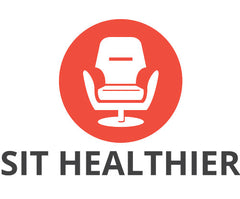Our joints start to deteriorate already in our 20s, and half of the 50-year-olds suffer from some kind of joint problems. Osteoarthritis is the most common joint disease in the world, which develops as a result of lifestyle, ergonomic conditions, diet, weight, and heredity.
Studies show that musculoskeletal disorders (MSDs) are the most common cause of seeing a doctor, and the treatment costs each year are enormous. The effectiveness of physiotherapy is significant compared to medication, and physiotherapy also achieves equally good results, but at a much lower cost, as surgery.
Much of physical therapy is exercise training, but posture training, such as correcting the sitting posture, also plays a major role in rehabilitation. Position control focuses on finding the central position of the pelvis by tilting it forward.
The position of the pelvis is the basis for posture both when sitting and standing. When sitting on a two-part saddle chair the pelvis can be in its central position because of the gap in the seat, and wide hip angles. When the pelvis is in that position the spine will naturally set up as an extension of the pelvis, and sitting in good posture is possible. In this position, the upper limbs are also resting, as the upper arms are positioned next to the body.

Our everyday life is full of little ergonomic choices. Can you stand for a long time? How do you work in the kitchen? How is your posture when you are doing household chores? In what kind of position do you do the ironing?
Joint-friendly everyday choices
The health of articular cartilages is essential for joint well-being. The cartilage has no circulation of its own but receives nutrients from the surrounding tissue fluid. The joints should move in order for their metabolism to function properly, as the movement pumps nutrients to the articular cartilage. Immobility and stooping impair the health of the joints and expose them to excessive or uneven loading. Prolonged pressure on articular cartilage prevents normal metabolism and the tissue begins to weaken.
The trajectories of the joints are wide. A healthy joint can withstand the strain and is not tired or damaged even when carrying heavy loads.
A moving joint is alive and well
Joint health is important for both individual and public health. There is a lot of information available about maintaining health, but our current lifestyle increasingly guides us to staying in place and taking unnatural positions.
Research shows that even a small movement has a positive effect on the prognosis. Exercise with sufficient intensity and repetition during the free time also has a positive effect. However, only 25% of Finns exercise enough. Thus, the harmful effects of sitting still affect up to 75% of the population!

Wide knee and hip joints enable the upright posture. The gap in the middle of the seat eliminates dangerous and uncomfortable pressure on the genital area.
Sit, stand or move?
Often, however, we have to sit, and for several hours a day. With small daily choices, we can influence our own activity and the amount of movement throughout the day. You can choose to sit on a bus, but sometimes you could try standing. In waiting rooms, chairs and accustomed habits invite you to sit down, but you don’t have to. The choices you make can have a huge impact on the overall activity of your everyday life. If you just can get moving, do it!
The active Salli Saddle Chair Swing models bring healthy movement to the day. The natural central position of the pelvis allows the natural curves and vertical position of the spine, whereby the vertebrae and the disks are evenly loaded also along the cervical spine. This also allows the muscles to maintain the posture to do their natural job. Muscle work affects blood circulation and thus also the oxygenation of tissues, which is particularly important for the well-being of the disks.
Source: Salli


Leave a comment